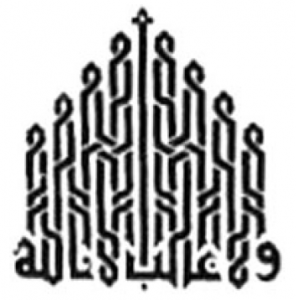Part VI: Settlements and Settlers
Chapter 14: The Women who Gave
THE IMMIGRANT MOTHER
“For all eternity America is indebted to the Immigrant Mother, whether she was an Italian, Jewish, Polish, Austrian, Hungarian, German, Russian, English, Slavic, Greek, Syrian, Bulgarian, Czech, or Irish . . . Born in the old country, she usually married at a young age . . . while her husband worked in the bitter cold of winter, or in the blistering heat of summer, in ditches laying sewers . . . she worked from early morning to late at night, cooking at a coal stove, washing her clothes with a washboard, and heating the water in a big copper tub on that same coal stove. At the same time, she took care of the children, preparing breakfast, making lunches, and sending them to school . . . her children must have an education so that they may be respected and amount to something someday . . . she is the unsung heroine and pioneer of America . . . may the people of America never forget what they owe to that sweet and blessed soul, the Immigrant Mother of us all.”
——— Anonymous
Although the early immigrants began to move out into the further west and east side neighborhoods within ten years of the earliest immigration, their first associations in the new country, like the immigrants from other countries, were within their own groups. Their American contacts were the business people, landlords, and school teachers within the immediate area.
Typical of these communities was the Bolivar Road settlement. Alva Bradley owned most of the tenements in this area, and Bradley Court became known as Il Babhour, the Boat, a continuation of the exodus from the motherland into the new country. It was crowded, hot in summer, cold in winter, and full of all the trials and tribulations that accompanied the confined experiences of the immigrant community.
A bright and aggressive young married woman, herself an early immigrant, was Bradley’s superintendent for the tenements. She collected the rents and responded to the tenant’s problems, serving as a liaison and interpreter between the landlord and her countrymen. Her name was Deebe Sahley, and she and her husband operated a stand in the market for years. She was a courageous woman and she became a legend at the market and among her own people. It was said that she could work longer and harder than half a dozen men, and her strong figure and big voice, calling out to customers, bargaining over prices, became the trademark of her “stand.” She was a shrewd business woman, level headed and straight forward and was much sought after for advice. Throughout her life, Deebe Sahley held a position of leadership, not only in the women’s circles, but among the men as well.
As the reasons for the early immigrations were much the same for all people — refuge from oppression, a chance to prosper, a search for adventure, flight from conscription into the Turkish army — so also were the life stories of the immigrants similar. Hard work, deep religious commitments, respect for law and order, and a love for the new country were the watch-words of their lives. The women, as homemakers laid the foundations for the lives of their American children.
The Story of Rose Joesph
A life long resident of Cleveland, Mrs. Abdallah Joseph says:
My father’s name was Abdallah Yousef Aftoora, and my mother was Asma Khalil Geha. My father was a cobbler in Zahle in the Lebanon, and he had a good business, but he was young and adventurous, and he heard that the people who went to Australia and South America were becoming very rich, and so he thought, “Well, I will go, and see what I can do.” Then his plans changed and he decided to come to America. First he would leave my mother and the children behind and he would come over here, work, and send for the family. But my mother was young and adventurous too, and she said, “No, if my husband goes, I will go with him.” So they left my two older sisters with our grandmother, and they brought me, an infant in my mother’s arms, to Cleveland. It was 1892 when we set sail. In a little while, my parents began to miss my sisters very much, but trips back and forth were not easy then. Finally after three years in America, we returned to Zahle. Then it was another five years before we came back again. This time, in 1900, my parents brought us three daughters and came to Cleveland to establish a new home.
We lived on Canal Street in the Flats, and on Bolivar Road in those early years. I remember that some of the first families were the Caraboolads, the Zlakats, the Zegiobs, the Nymes, the Jalatys, who were originally from Baalbek, a Mr. Fatouche who owned a dry goods store, the Ottos, the Amors, and the Karams. There were the Makhouts who were the first to move to East 105th Street, (Doans Corners) which was really considered very far away from town.
Rose Joseph recalled that there was a Mr. Najeeb Zlaket who had a big job at the Workhouse and that other people also began to get jobs with the city and with the county. That was considered a real advancement in those days, particularly since Syrians and Lebanese in their own country were limited to minimal participation in the administration of their own towns and villages. Only the most influential and wealthiest were selected by the Ottomans to represent their people in the millet governments established by the Turks. Therefore, it was a stimulating experience to be an employee of the government in America. As a small girl, Mrs. Joseph was sent to old Eagle school, then to Brownell, and to St. John’s Cathedral School where she studied for First Communion.
She was a familiar visitor to St. John’s and to the Bishop’s office. “I remember,” she said, “that my father and our priest would take me with them to Bishop Horstmann so that I could interpret for them while they discussed plans for a new church for our people. I never could understand why,” she laughed, “because they would only be there a few minutes before they all started jabbering in French, and there I was, bored to death, not understanding anything they were saying. Each time they went, I would say to my father, “You don’t need me to go along, but he would say, ‘Never mind, you come.’ I don’t think I was ever much use to them, they all got along so well, but anyway, I really got to visit the Bishop.”
She recalled that before the Syrians established the first church in a building on East 9th Street, masses were sung as early as 1901 in the Melkite Byzantine Liturgy in the Chapel of St. Joseph Franciscan Church at East 23rd and Woodland, and also at St. John’s Cathedral.
“We had Palm Sunday processions there,” she said, “and every one would come out to see the Syrian children dressed in their Easter clothes, carrying candles and flowers, marching around the Cathedral.”
In describing the sense of unity the early settlers had with each other, Mrs. Joseph noted that the founding families of the first eastern rite church, St. Elias, were not all of the Melkite Byzantine following. There were Maronites and Antiochian Orthodox as well, whose churches would not be established until some years later, but so lonely were they for the ancient liturgies that they too joined in founding the first church and participated for years in its ceremonies and functions.
Probably the first of the language schools was one conducted by a young doctor, Khairallah Karim, who became known as “Mouallam” (teacher) Karim. In the early years of the century, he set up classes at the Friendly Inn and taught Arabic to the young people who had been brought over at a pre-school age, or who had been born in the United States of the first wave of immigrant parents. As he taught these students Arabic to help them preserve the mother tongue, he also taught English to others to prepare them for entrance into school, or to assist the young adults in preparation for their citizenship papers.
Rose Aftoora, who had been brought to America as an infant, taken back to the old country as a child of three, and returned to America at the age of eight, attended Mouallam Karim’s little school and learned the language which would otherwise have been lost to her.
There was also a club, she remembered, called Wardot Sooria, Roses of Syria.
In 1918, she married a man from Utah who was visiting in Cleveland. His name was Abdallah Joseph, but all his life he would be known, because his home city was Tyre, the Arabic Sur, as Abdallah el Suri or Abdallah the Suri.
“It was wartime,” she recalled, “and my husband went into service, but he didn’t have to go overseas for which we were grateful. There were many many men from our Cleveland community who went into the army, which when you think about it was really rather unusual. You know, many men left Syria because they did not want to be conscripted into the Turkish army, but when America entered the war, they signed up to serve. Some weren’t even citizens yet, but that gave them a chance to get their citizenship, and some who were already citizens wanted to fight for the new country. I guess maybe it was because America was free, and their old country, Syria, was still not free for its own people. Anyway, it always surprised me how many of our men were veterans of the First World War.”
The Josephs moved to a large house on West 14th Street, which was then a fashionable and prosperous neighborhood to which many of the Syrian Lebanese were moving, away from the Haymarket and downtown districts. Social functions centered around the churches, and some cultural activities took place at the settlement houses.
There were plays produced in Arabic at Alta House, which was at that time at East 22nd and Woodland.
“In the 20’s,” Mrs. Joseph said, “they all used to come to our house to practice their plays in our basement. There was my cousin, George Aftoora, and Dr. Halim Khoury, Shikry and Sadie Shantiry, and there was Alia Owen, Alice Hankish, and Adele Gantose, and I can’t even remember how many others. Why they even went on the circuit. We used to go to Toledo and Akron and cities all around to put on the plays. Later on, they did operas in Arabic, and they were beautiful. Our lives were not so complicated then,” she continued. “We had simpler needs and pleasures, and nobody thought very much about getting everything at once, or taking big or expensive vacations each year.”
One of the highlights of many a family’s year from the twenties through the forties was the annual trip to Carey, Ohio to the Shrine of Our Lady of Consolation. Here some miraculous cures had been effected years before and the little church and small town of Carey became a focal point for many of the nationality communities.
The Poles, Slovaks, and other Middle European people, as well as the Syrian-Lebanese devoutly celebrated, each August 15th, the Feast of the Assumption at the Shrine of Our Lady of Consolation. The walls of the tiny church were hung with mementoes of pain — crutches, canes, hearing aids, eyeglasses, all left behind by the faithful who felt they no longer needed them.
Mass after Mass would be celebrated by priests of the different nationality groups throughout the three days of prayer and processions.
The blue and red glass of vigil candles glowed continuously, shadows of tiny flames flickering against the walls, and all the women, Arabs, Poles, Slovaks, Hungarians, Russians, would tiptoe reverently into the little church, to practice the ritual of lighting the vigils. Dropping their coins into the vigil racks, they would then ceremoniously light the long wick to touch it to the pure beeswax candle, self-consciously shake it to put out its flame, and drop to their knees before the tiny symbol of their hopes.
Throughout the day, the little church would echo the soft sound of prayer, whispered in many tongues.
“Assist my daughter, dear Mother, to have this baby she has wanted for so long.”
“Help my son, dear Mother, for the sake of your own Loved Son.”
All the timorous hopes of the human soul went into those little prayers of the trusting faithful. In the Church and on the streets, the prayers continued, as throngs of people in long and colorful procession followed steadfastly behind the acolytes and priests, intoning their messages to the Holy Mother. Their gaze was fixed upon the Madonna’s banners, the crucifix at the head of the procession, and most steadily, and with awe, upon the silk dressed and bejewelled figure of the Lady of Carey, lifted high above the heads of the crowd, her blessing touching all who believed.
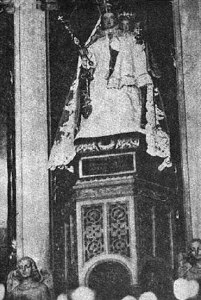
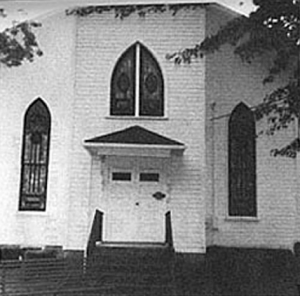
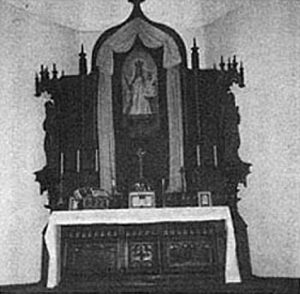
But all was not prayer and sombre solemnity.
“All year,” said Mrs. Joseph, “when I would buy my little girls dresses, they would say, ‘Oh, this one will be for Carey.’ That would be our vacation, and the whole family looked forward to it. Each year, we would go on the train, and always we would stay with the same family in Carey. They would have our rooms ready, and the Mister would be waiting to take the children down to see his corn and the cows and horses. Oh, what a good time they would all have.”
Names of Carey residents like Powell and Haberman and White were linked for years with the vacation days of Arab families like Joseph and Jacob, Aftoora, Kaim, Hatton, Abdallah and Abraham, Haddad and George. The Syrian-Lebanese, unlike some of the other nationalities, would plan great festivities for the evenings after the days of prayers.
People came from everywhere — from Detroit and Chicago and from Akron, Youngstown, Canton and Cleveland. Blufton, Amherst, Fostoria and Toledo were represented. They came even from New York, and up from the South — from Birmingham and Jacksonville — and points east and west, for Carey was a place of reunion.
The peaceful serenity of the park at night would be broken with the sounds of song and dance, the derbecki thumping and thrumming out the old folk music. At the first notes the debki chain would form, the best dancers leading the long line, waving their handkerchiefs to the music and calling out for all to follow.
The finest oud players in the United States coaxed golden notes from that plaintive instrument, playing soft accompaniment to the most renowned Arabic singers in the country. Musical notes and human voices rose as one in the summer air of that midwestern farm town of Carey.
Young people would walk about the grounds and find benches under the trees, lost in their own romancing, yet never far from the watchful eyes of the family elders. Many a match was made during the shrine days at Carey.
There was much food and drink and merrymaking, and nearly every Cleveland family had a favorite tale to remember about the days when Carey, Ohio was the big summer vacation.
“Those were wonderful days,” Mrs. Joseph reminesced with a smile. “We did everything. We prayed, and we marched in the processions, and then we went to the park to spend the evenings with everyone we knew and loved. We sang and danced and had a wonderful time. And isn’t that the way it should be, after all? Like the Bible says, ‘there is a time for prayer, and a time for pleasure.’ How good when we can share all of that together.”
The Story of Barbara Jacob
The demographic character of the Cleveland Arab community did not change significantly until after the partition of Palestine in 1948 and the Arab Israeli War of 1967, factors which accounted for the exodus of displaced Palestinians, thousands of whom eventually came to the United States, many settling down in Cleveland.
However, an early Cleveland arrival from Palestine was Atullah Jacob. Even in those days, Ramallah, in the East Palestine district of Jerusalem, was a lush and prosperous city. Its farms and gardens nourished by the waters of many natural springs, Ramallah was fast developing into a resort and tourist attraction.
Atullah Jacob, nevertheless, was not content to remain in his native city, but was determined to come to the America he had learned so much about from the American Presbyterian teachers whose faith he followed.
He arrived in Cleveland in 1902 and died here in 1975 at the age of ninety-five.
“He was very proud of his name,” said his widow, Mrs. Barbara Khattar Jacob. “Atullah means ‘gift of God’ and all his life he said it was his obligation to live up to that.”
Barbara Khattar arrived from the Lebanon in 1913 at the age of fifteen, going first to Youngstown to her cousin’s home.
“I wanted to earn some money to send home to my family in our village near Batroun, but then the war started in 1914 and communication was cut off. When I came to Cleveland,” she said, “I went to work in a cigar factory at Woodland and East 14th Street with some other Syrian women. We earned $2.00 a day. That was good money then.
“Then some friends I met said that was not an easy job for a young girl, and offered me a job in their restaurant. The owner’s name was Khalil Tuma, and I became good friends with his daughter Selima and shared a room with her in their house.”
Atullah Jacob was, by that time, a partner with Khalil Tuma in the restaurant. “I didn’t pay much attention to him at first,” said Mrs. Jacob. “He was much older than I was, and of course, he was one of the bosses.
“One day I got mad at Mr. Tuma because he was angry with something I did, or maybe didn’t do, I don’t remember. He swore at me, at least I think it was some bad words, and I was very humiliated and so I ran away from the restaurant and from the house. You see, the expression that is used is really a curse on your father, and I couldn’t stand for that, could I? After a week, some of the men came to my other friends where I had run away to, and they acted as a delegation to make peace between me and Mr. Tuma. I remember Mr. Orfalie, who owned a linen store at the Arcade. He was very kind, but stern, and he asked me why I was so angry with Mr. Tuma who ‘loved me like his own daughter.’ I said I didn’t think it was nice of him to swear at me, and Mr. Orfalie said, ‘So what is that my girl, didn’t your own father sometimes swear at you? Come on now, didn’t he?’
“Well, I cried, and they made me and Mr. Tuma make up, and Mr. Tuma who was really a good man, well he cried too. And so he hugged me, and kissed my cheek, and we made it up. Then I went back to work in the restaurant and back to living with Selima at their house, and we all got along very well.”
About that time, Atullah Jacob began expressing his intentions toward Barbara Khattar, but at first she was dissuaded by friends.
“‘He is a good man,’ they said, ‘but he is much too old for you. And more, he is a Protestant and a Palestinian and you are Maronite Catholic and Lebanese. These mixed marriages don’t work.’
“But finally I decided it would be all right. I could turn for him and be a Protestant, too, because after all aren’t we all under the one God? And what if he was not from my own country, what of that, we were all Arabs anyway.
“We were married in Mr. Tuma’s house, and Selima was my bridesmaid and Juryous Hishmeh who was also from Ramallah was Atulla’s best man.”
They went to live in a house on Central Avenue and soon started a restaurant of their own.
“Our restaurant was at 656 Bolivar Road. We cooked many things. Ham and eggs, and other American foods but also some Middle Eastern food.”
In 1919, their first son was born. “I didn’t know much about those things, and I walked from the restaurant to the Maternity Hospital which was on Cedar because I had some pain, but I didn’t know the time had come. Well, they knew, the nurses, and they wouldn’t let me go home. My boy was born that night.”
The birth of a first son was a joyous occasion and everyone coming to the restaurant was treated to “Bahlawa” the rich nut filled, syrup soaked pastry served at Middle East festivities.
Early menus at the restaurant were cheap and filling. “We sold a plate of ‘Kibbee’ for 25 cents. Two ‘Kousa’ were also 25 cents. Rice was 5 cents and so was a dish of laban (yogurt). Chicken with ‘hashwee’ (meat and rice stuffing) was 25 cents, and ‘Mishwee’ (shish kabob) was 25 or 30 cents, I don’t quite remember.”
The Jacobs operated their restaurants for thirty years and catered weddings and parties. They provided for the education of their four children from the profits of their business.
“When we lived so close to downtown,” Mrs. Jacob remembered, “I would sometimes get so sick for the smell and the feeling of the grass, and the open air that was in my own village, that I had to run away from the sidewalks. I would take my children when they were little, and we would walk to the Erie Street Cemetery, and today they laugh when they remember I let them play in the cemetery under the trees. It was so quiet and pleasant there, and there was nothing frightening about it for us. We just took it for granted that here was another step in life.
“We found out when the memorial ceremonies were held by the Indians who came to visit and pray for their dead who were buried there. They used to tell me that the Indians who helped the first Cleveland settlers were in that cemetery, and I recall that there was once a fight between the city government and the Indians about how the graves were cared for and what would eventually become of them.
“It was good for all of us to be there among the natural things, and away for a while from the automobiles, the streetcars, the factory whistles, and all the business. It was good to smell the fresh air and to sit on the grass, and lean my hand upon the soft moist ground.”
The Story of Helenie Farage
Gently smoothing the yellowed silk and soft chiffon of her wedding dress, Helenie David Farage noted that its tunic style and rose point lace trim would fit in nicely with the mode of the present day, and she had worn it as a bride over fifty years before.
Her daughter-in-law said, “It looks as if it would still fit you today, Mother, if you would try it on.”
Helenie laid the fold creased gown against her breast and smiled. “My veil just went to pieces years ago. They were illusion silk net in those days, very sheer, and we wore them to the floor, all crumpled against the train of the dress, but they were gone the minute the air got to them. Not like the new nylon they have today. That would last forever.”
Her story, she said, was not different from all the stories of her friends. “We came here, most of us young girls and young men, and it was to have a better life than back home.
“But yes, I did have a little harder time at first. You see, I was thirteen when we went from Mashta in Syria, to the Port of Tripoli. I remember that we left Tripoli on July 19, 1910, and it was a long hard trip until we got to Marseilles.”
It became even more difficult at Marseilles for Helenie David. Her papers were not completely in order and she could not be permitted to enter the United States. “It was a very big problem for my parents. I was the youngest of the family so what should they do? Could they leave me alone in Marseilles, or should we all return to Syria, and try to get back to America again? That would not be easy. It took a long time to save money to bring a family to America.”
A relative was finally found who would look after the young girl so that the rest of the family might be able to continue on to Ellis Island and America.
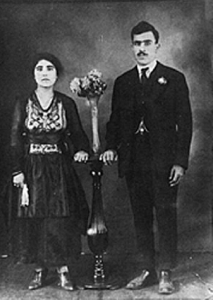
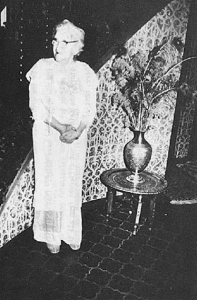
“Then my aunt arrived in Marseilles on her way to Argentina, and she took me with her to South America. When my father sent my papers to Marseilles they wrote back and told him I was in Argentina and then he had to get them to Argentina so that I could come to America to my family. That was something to have those visas and permits travelling from Marseilles in France back to my father in Amherst, Ohio, and then out to Argentina, all to get a young girl into America to her family.
“Well, finally the papers got to South America and I arrived in America in 1912, two years from the time we started out from the Port of Tripoli. I was only with my family in Amherst for two years after all that, you know, or until I was seventeen, when I got married.”
Khalil (Charles) Farage was from Colorado. “It was a little town — maybe you’ve heard of it, Wallsenburg, that was the name. You know, he had a bad time too for a while. You see, he wanted to get to America, but first he went to South America because that was easier. He was not happy in South America and what he did then was to get to Mexico. Well then, he got into America from Mexico and went to Wallsenburg. You see he wanted to come to America so much that he couldn’t wait for all the papers. He was a wetback and it took him years before he got his papers straightened out.”
The Farages stayed only a short while in Amherst then came to Cleveland where there were more job opportunities.
Like many other young Syrian couples, their life in Cleveland began on Bradley Court.
“We had two rooms and a kitchen. Everybody had plain chairs and tables, not like today when couples start out with everything matching.”
In those early days, life styles were based on temporary arrangements. Many were not certain they could even make it in America and home decorating was low on the list of priorities.
As jobs grew steady and the family prospered a sense of security and permanence developed.
“I remember one family, the Anters, bought a couch and two chairs that were a set, and everyone went over to see it, and soon the other women started buying couches and chairs that matched.”
Life for Helenie and Khalil Farage centered around their religion. They were Orthodox and did not yet have a church of their own.
“Visiting priests would come to Cleveland, and we would have Mass in different homes. Father Sliman Merhis, who married us in Amherst, used to come here and we would have Divine Liturgy in the Armory on Bolivar Road. We used the billiards room for our services. Yes, there was Father Merhis, and then there was Father Spiridon Massouh who used to come up from Akron. Later he went to Canton and was the priest there for years. They had a big parish in Canton.
“When Father Massouh could not come, Father Atouf would visit us. We had Mass in many places, but Gray’s Armory was the central location for a long time.”
When no priest could visit, the Orthodox families would share in the services at St. Elias Melkite Church which was then on Webster Avenue near East 9th Street.
“Before we had our own church, we all went to St. Elias. We had weddings and funerals in that church no matter what religion we were. When there was something big happening everybody came — the Melkites, the Maronites, the Orthodox. The Druze came too. It didn’t matter what we were — even that some were not Christian. It was important that we were all Arabic people and we stayed close to each other. We lived across the street from the church on Webster, and my second son was baptized by Father Mufleh who was the pastor. Oh, he was such a good man. You wouldn’t believe how many people he helped. He used to get in trouble with his own people sometimes. You know why? He didn’t keep real good books, but they didn’t know about some of the good things he was doing. Some of the people who had a real bad time, especially in the Depression later, they knew.”
While Khalil and Helenie Farage attended services in other churches, they worked and planned with others of the early Orthodox families for the establishment of a church of their own.
“We did everything. We had bazaars, we had parties, the men had meetings and formed a Council. Even during the hard times, people worked to build the church. And do you know, when we finally had our Church and our Pastor, we were in it only a few years and the church burned. To the ground. Nothing was left, only the walls. We had just decorated it and we had a big party to celebrate — and the very next day the church burned. It was terrible to see it all gone, just four walls standing. Then everyone just dug in and went to work all over again. It was the middle of the Depression and the men who were plumbers and carpenters went in and put in plumbing and a floor. They finished the basement in a few months so we could have Mass again in our Church. When I look today at our church building, the halls and the school rooms, I think of those people who sacrificed and paid off the mortgage and worked so hard. It was a very good thing, because that way our own religion is not lost in America, and our grandchildren have the church we built.”
